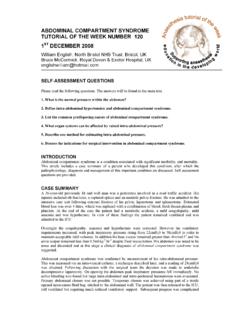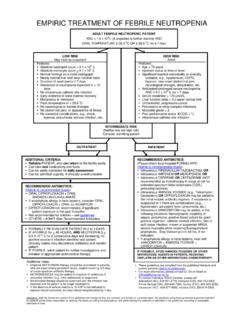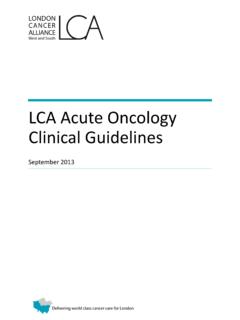Transcription of Integrated Management of Childhood Illness (IMCI)
1 CHAPTER 5 III. Integrated Management of Childhood Illness ( imci ). Tigest Ketsela, Phanuel Habimana, Jose Martines, Andrew Mbewe, Abimbola Williams, Jesca Nsungwa Sabiiti, Aboubacry Thiam, Indira Narayanan, Rajiv Bahl Every year, nearly 11 million children die before reaching their fifth birthday. In response to this challenge,WHO and UNICEF in the early 1990s developed Integrated Management of Childhood Illness ( imci ), a strategy designed to reduce child mortality and morbidity in developing approach focuses on the major causes of deaths in children through improving case Management skills of health workers, strengthening the health system, and addressing family and community practices. However, the original imci . modules did not include care of the sick newborn during the first week of life, the time when one in three child deaths occur, and it did not emphasise home-based newborn care. imci has become a main child survival strategy in almost all countries in the African region, creating a unique opportunity to scale up newborn health interventions using imci as a vehicle.
2 Incorporating newborn algorithms in imci and strengthening the components of the strategy related to the health system and community will directly impact newborn health. Some of this work has already begun as generic imci guidelines and training materials have been revised to include the first week of life. Many countries in Africa are planning to adapt imci to include the missing aspects of newborn care. Questions about adapting imci in Africa remain, however. For example, should routine home visits for postnatal care in the first week of life be included in the imci strategy? Should imci . include care at the time of birth? Should imci training start with Management of young infants (0-2 months) rather than older infants and children? What are the challenges in implementing imci in an effective way? How can complementary facility-based and community-based approaches be combined? Many lessons can be gained from countries, especially in Asia, where imci has already been adapted to Integrated Management of Childhood and Neonatal Illness (IMNCI).
3 Opportunities for Africa's Newborns 91. The problem The health of children is closely linked to the health and care of their mothers. As the newborn grows into a child, healthy home behaviours and care of illnesses are crucial to save lives. Lack of care, or poor quality care, has effects for newborns and children: Effects on newborns: Every year million African babies die in the first month of life and the leading cause is majority of the estimated 325,000 babies who die from neonatal sepsis and pneumonia could be saved with simple preventive practices such as clean skin and cord care, breastfeeding and warmth, and better Management of those who are sick, especially using Most newborn deaths are among low birthweight (LBW) babies, or babies weighing less than 2500. grams at birth. Simple care of all small babies and early treatment of complications would save many newborn lives. However, neither home care practices nor care of small babies, or even treatment of newborn infections have been systematically addressed by child health programmes at scale, including Integrated Management of Childhood Illness ( imci ).
4 Effects on children: Lack of health promotion and services for babies has an impact on older children too. Severe Illness during the first month of life can result in long term disability and poor school performance but there is little concrete data available on these serious newborn illnesses and their long-term effects on first weeks of life are crucial for establishing healthy behaviours, such as breastfeeding in Africa only one third of babies under 6 months of age are exclusively The imci package and timely careseeking improved through community imci (C- imci ), while imci training increased quality The Integrated Management of Childhood Illness of care at the health facilities. This combination of ( imci ) strategy is central to the achievement of child community and health facility approaches resulted in survival and development, a key principle of the substantial increases in the use of Figure Convention on the Rights of the Child.
5 The strategy is illustrates the effect on survival of interventions in the based on human rights that guarantee health care to all three imci children, no matter where they live, and is implemented by addressing the gaps in knowledge, skill, and Improving child survival Figure community practices regarding children's health, through the three components of imci . recognition of Illness , home Management of the sick child, and appropriate careseeking behaviour. The imci . strategy includes three important components: 1. Integrated Management of ill children in facilities and health centres 2. Health system strengthening, particularly drugs and logistics support 3. Community imci , or promotion of key family and community practices The three components of the imci strategy are most effective when they are implemented simultaneously. For example, imci training to improve the skills of health workers for better case Management in health facilities, accompanied by health systems strengthening efforts, such as improving the supply of essential drugs, resulted in a 13 percent reduction in under-five mortality in two years in In Bangladesh, home care for Illness Source: References 5;6 Reproduced with permission of WHO.
6 92 Opportunities for Africa's Newborns III. Figure imci case Management at first level health facility, referral level, and home FIRST LEVEL HEALTH FACILITY REFERRAL LEVEL. Ask about CHILD'S PROBLEMS PINK - EMERGENCY TRIAGE. ADVISE. PRE-REFERRAL ASSESSMENT AND. Check for parents TREATMENT TREATMENT. GENERAL DANGER SIGNS about AND. REFERRAL. REFERRAL DIAGNOSE AND TREAT. COMMON SERIOUS. CONDITIONS. ASSESS for MAIN SYMPTOMS: MONITOR PATIENT. CLASSIFY. COUGH OR DIFFICULT PROGRESS. CHILD'S YELLOW - BREATHING DIARRHOEA TEACH. CONDITION SPECIFIC. FEVER parents AND TREATMENT AT HOME AND FAMILY. IDENTIFY about FIRST LEVEL. TREATMENT treatment FACILITY. GIVE ORAL DRUGS. ASSESS for COUNSEL AND/OR. MALNUTRITION them TREAT LOCAL INFECTION. AND ANAEMIA about feeding and when GREEN - to GIVE FOOD AND FLUIDS. HOME. return (follow feeding Check for OTHER PROBLEMS Management . recommendations). RETURN TO HEALTH. Give FOLLOW-UP care when the child returns, and if necessary, FACILITY.
7 Reassess for new problems WHEN NEEDED. Source: Adapted from references 5;6. imci functions best when families and communities are imci combines prevention and care, focusing on the linked to the first level facility which in turn links well to child and not only on the individual diseases. The types the referral level. (Figure ) This is the same of interventions currently in the imci strategy are shown principle that is set out in Section II regarding the in Table importance of a seamless continuum of care across health service delivery levels. Table Types of interventions currently included in the imci strategy LEVEL TYPES OF INTERVENTION. Illness prevention and growth promotion Response to Illness (curative care). Home and Community/home-based promotion of Early recognition and home Management community appropriate infant feeding practices; peer of Illness counselling for breastfeeding and Appropriate care seeking complementary feeding Adherence to treatment recommendations Use of insecticide treated bednets Appropriate infection control practices Health Vaccinations Case Management of acute respiratory Services Micronutrient supplementation infection diarrhoea, measles, malaria, Health worker counselling for breastfeeding malnutrition, and other serious infections and appropriate complementary feeding Counselling on feeding problems Iron for treatment of anaemia Antihelminthic treatment Opportunities for Africa's Newborns 93.
8 Current coverage of imci period has only recently become ;13 When the algorithms were originally developed, it was considered imci is currently being implemented in more than 100. that care around the time of birth and the first week countries throughout the world., As of June 2006, 44 of were to be mainly addressed through maternal care 46 sub-Saharan African countries in sub-Saharan Africa programmes, although in reality newborn care falls in the are in various phases of imci implementation, with 27. gap between maternal and child care expanding beyond a few initial implementation districts. Fourteen of these 27 countries are carrying out the Further, in imci implementation the emphasis has been strategy in more than 50 percent of their districts on delivering interventions through the formal health (Figure ). care system. However, many of the simplest first steps to save newborn lives require delivery approaches that are Figure Progress towards scaling up imci in community based.
9 The key family and community the WHO/AFRO region as of June 2006. practices originally identified in the imci strategy did not focus on newborn care practices such as early initiation of breastfeeding and thermal care. Strengthening the newborn interventions in each component of imci would contribute to saving many newborn lives, and would also benefit imci itself through further integration of the three components of the imci strategy. In this way, imci programmes can strengthen the continuum of care by promoting activities that enhance newborn care practices within the family and providing support to vulnerable newborns. In particular this applies to providing care for LBW babies, identifying newborns with signs of severe Illness and Early Implementation facilitating timely referral, and improving the quality of Phase care for newborn Illness at primary and referral care Expansion Phase facilities. Follow-up of babies with problems identified because of a maternal condition, such as syphilis or HIV.
10 imci in more than infection, would also become a priority of child health 50% of districts workers as a result of improved hand-over between maternal and child health services. imci implementation has been evaluated through two Case Management of Illness in first level health large efforts: the Analytic Review of IMCI7 and the facilities opportunities to include newborn Multi-Country ;6 These reports have found interventions that imci training substantially improves the quality of The first and most effectively implemented component of care in health ;8-10 Still, while some countries imci has been the Integrated Management of ill children have reached high coverage, most countries have in facilities. The core principle is to improve the ability of progressed much more slowly than initially health workers to categorise sick children using simplified The focus of imci strategy in many countries has been algorithms to identify very severe disease requiring referral more on health worker training than the balance of all and other more simple conditions which can be treated at three components.















